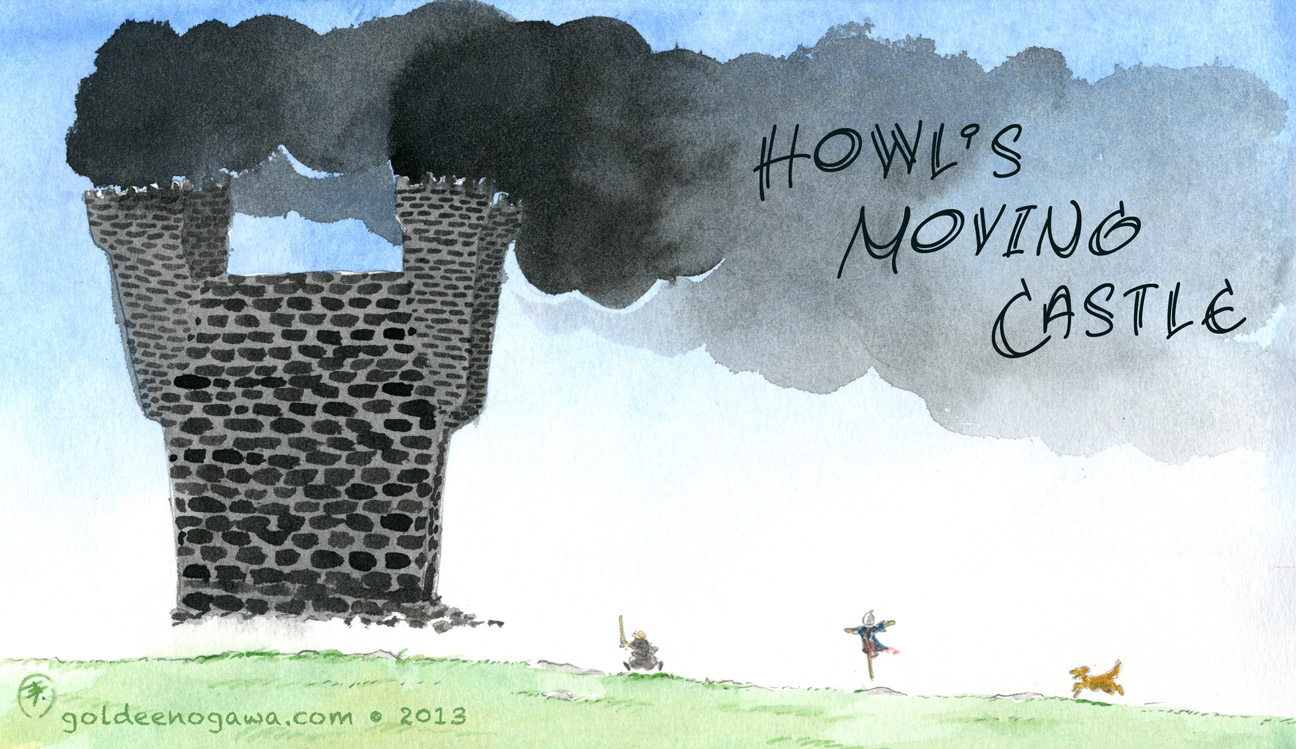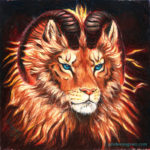This month (March) has been declared #DWJMarch, in honor of the late, great Diana Wynne Jones, by K over at WeBeReading.com. This year she is hosting a read-along of Jones’s delightful novel Howl’s Moving Castle, and in honor of that I thought I’d share my thoughts on the book—and do a little fanart.
Reflections on Diana Wynne Jones’s

Howl’s Moving Castle (1986, Greenwillow Books of New York) is probably Jones’s best known work, along with the Chrestomanci Books, thanks in no small part to the movie adaptation by Studio Ghibli. And while I have nothing against the film (indeed, Miyazaki-san falls short only of Jones on my list of creative heroes), I must admit that I find it contains but a fraction of the joy, wonder, bewilderment, excitement, hilarity and sheer cheeky cleverness of the book. If you’ve seen the movie but not read the book, please read it immediately. You owe it to the movie to find out where it got all its best bits from.
[Look! It is available from Amazon in paperback, eBook and audio and from iTunes as eBook and audiobook. Get reading!]
It should be mentioned at this point that I read the book ages before the movie was even conceived. How young was I? Well, I thought Wales was another made-up country. (!) I remember reading on Jones’s official fan site the announcement of the movie, and how Diana had been having meetings with Japanese people and “drinking lots of tea.” I recall there was much high-pitched excited screaming involved.
Go and catch a falling star
Get with child a mandrake root
Tell me where all past years are
Or who cleft the Devil’s foot.
Teach me to hear the mermaids singing
Or to keep off envy’s stinging,
And find
What wind
Serves to advance an honest mind.
Decide what this is about, write the second verse yourself.
—Excerpt from Song by John Donne (with Miss Angorian’s note), which proves crucial to the plot.
Howl’s Moving Castle is a fantasy-romance-fairytale-adventure story about a wizard, a witch, the eldest of three sisters, a scarecrow, a dog, green slime, shooting stars, and (yes) a moving castle. It is set in a magical land where common fairytale tropes are the rule of thumb, except when they’re not. It is mad and wild and chaotic and clever and touching and perfect.
When I first read the book as a child I didn’t know much in the way of classic fairytales. Oh, I knew the story of The Little Mermaid and Snow White, but I’d never developed an affinity for them. I’ve always preferred books that parody (though it be gently) those standard tales. So reading Howl for me was less like reading a parody, and more like reading the real thing. Except that Howl’s Moving Castle is far better. It is not just a children’s fairytale; it is a story about falling in love with a faulty character and learning to stand up for yourself.
The story begins in madness and chaos, continues in the spectacular fashion of a train wreck, spewing brightly colored bits of plot in all directions, until in the third act everything explodes like someone put a match to a warehouse full of fireworks.
And when at last the smoke clears and the dust settles we are left not with a burning pile of rubble, but with a perfectly clear and astounding image. All those pieces sent flying have fallen into place, and we can see the pattern that was always hidden in the chaos. The train was never crashing—it was transforming into an airplane, and now it’s flying through the air!
People who’ve read Diana Wynne Jones know the feeling: the one constant across all her books (aside from their impeccable quality) is her penchant for having explosive, chaotic stories that fall neatly into sense and order at the last minute. Howl’s Moving Castle is a wonderful example of just that.
But it is more than just an explosion. There’s a tightness to the order of the events in the story; a chain reaction, like dominoes. Reading the book is like watching a row of dominoes tip over; each event leading smoothly to the next until you realize that the dominoes, as they fall, are revealing a bigger picture.
This domino effect is one of the strengths of the book. Not a word nor sentence nor paragraph is wasted. Events and feelings and scenes come chasing each other across the page, sometimes nipping on each other’s heels, and unless you are reading with your full attention you are going to miss something. I have read it more times that I can count, and I’m still finding things I missed before: the preciseness of the attributes Sophie prescribes to her hats; Calcifer’s hints as to his true nature; Howl’s actual motivations.
The true magic is that all these impossible things, from enchanted hats to blue-and-silver suits, to seven-league bucket-boots, falling stars, moving castles, and a door that leads four places at once, are all believable. Not just because Jones treats magic as though it were perfectly real, but because she treats it in such a way that the reader believes it is real. She grounds it with realistic characters who, when faced with extraordinary circumstances, react with the same inspiration, cleverness and stupidity that an ordinary person would. With Jones’s magic anything can happen, but the real magic is that she makes you believe it can happen.
The same thing applies to her romance. People squabble, they fight, they declare one another to be “terrors” or “cowardly louts.” And in the end they get together and live happily ever after. But not in that “little cottage with a white picket fence way,” more in a “giant moving castle with a fire demon in the hearth” sort of way. Which is, I think, much more satisfying.
To any child or young person thinking of reading it, I can say: “You are in for a treat: this book is a fantastic adventure.” To any adult who may be worried about picking up a “children’s book,” I say this: “Leave your worries on the dust jacket, my friend. For this is a timeless tale, and like the door of the moving castle it opens upon many places.”
Reading Howl’s Moving Castle is one of the best things I could prescribe to anyone; it will make you smile, then laugh, cry (happily), and finally dance about in joy. Like eating one of Cesari’s cream cakes; you are only sad when it’s over because you’ve finished. Except unlike a cream cake, you can enjoy the book over and over again, and never fear of getting ill.
If thou be’st born to strange sights
Things invisible to see
Ride ten thousand days and nights
Till age snow white hairs on thee,
Thou, when thou return’st, wilt tell me
All strange wonders that befell thee,
And swear,
No where
Lives a woman true and fair.
—Second verse of Song by John Donne. All impossible things named in the poem come to pass before the book ends.
Notes on the Sequels
Howl’s Moving Castle has two loose sequels. I say “loose” because though they take place in the same world and share some of the characters, they are each vastly different stories.
Castle in the Air is an adventure featuring a vaguely Arabian lead character, a genie in a bottle, and a flying carpet (neither of which are as they first appear). Sophie and Howl do not show up until near the end. For this reason I think it gets a somewhat unfair rep from the fans. But I read it before Moving Castle, and I think it is quite good when judged on its own merits. Certainly, it has a distinctly different flavor from its predecessor, and I find that refreshing.
House of Many Ways is absolutely delightful. Again, it is set in a place that has only been alluded to in the previous books, and features an entirely new leading cast (though characters from both Howl and Castle in the Sky make appearances). If I didn’t hold Moving Castle so near and dear to my heart, House of Many Ways would probably be my favorite. Though Howl himself is only present for a few key scenes, he is at his absolute best and should not be missed.
Both sequels (and the original) are available in paperback, eBook and audio from Amazon. I cannot recommend them enough to readers of any age.
“Thank you,” he said. “Stop there. I won’t trouble you for the rest. Even the good woman is untrue in the last verse, isn’t she? I remember now. Silly of me. John Donne, of course.”
—Wizard Howl
Goldeen Ogawa was born on August 15th, just one day shy of Jones’s birthday. She is not sure whether she is happy to be born so close, or disappointed that she missed it. You can email her at goldeenogawa@gmail.com or peck at her on Twitter @GrimbyTweets.
Diana Wynne Jones wrote dozens of books, all of them good, most of them fantastic. Her other works include The Chrestomanci Books, Dark Lord of Derkholm, The Homeward Bounders, The Merlin Conspiracy, and Goldeen’s favorite book of all time: Hexwood. Her official fan site can be found here.
























